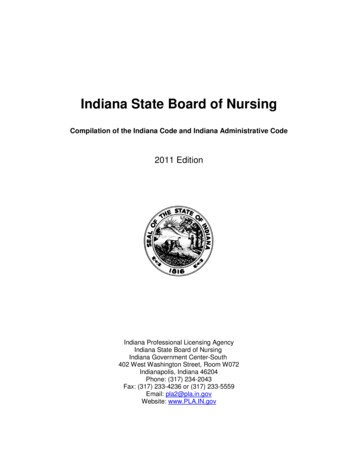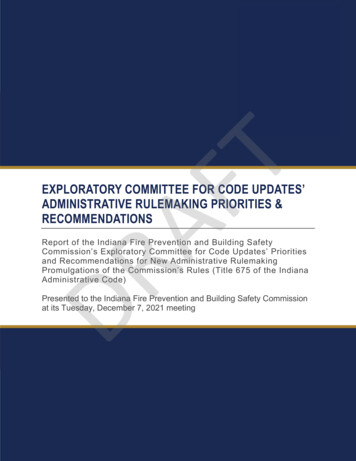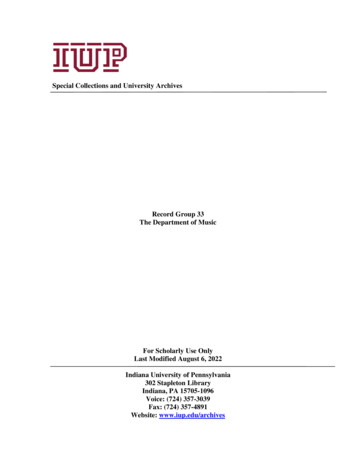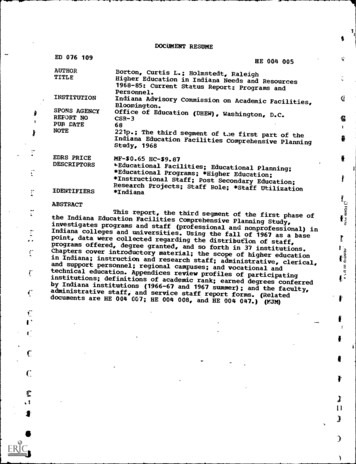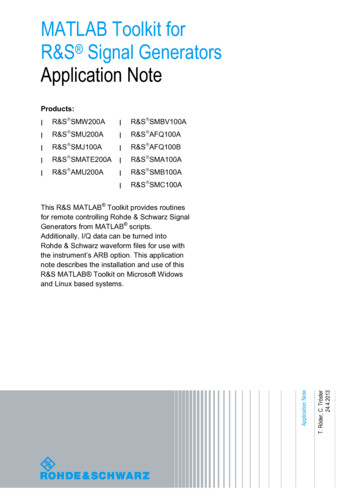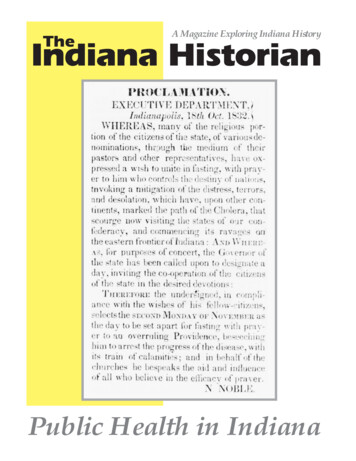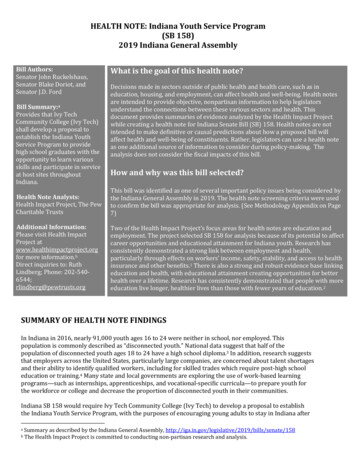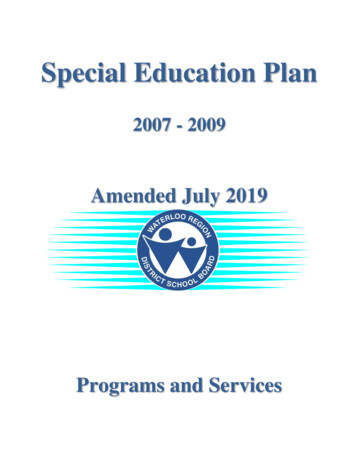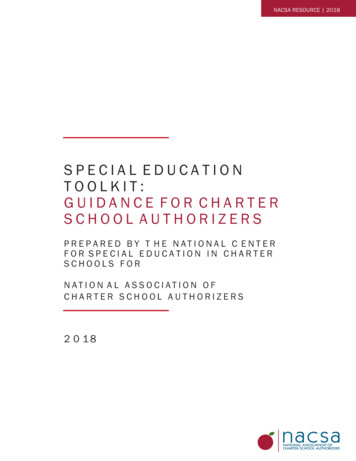
Transcription
NACSA RESOURCE 2018SPECIAL EDUCATIONTOOLKIT:GUIDANCE FOR CHARTERSCHOOL AUTHORIZERSP R E P A R E D B Y T H E N AT I O N A L C E N T E RFOR SPECIAL EDUCATION IN CHARTERSCHOOLS FORN AT I O N A L A S S O C I AT I O N O FCHARTER SCHOOL AUTHORIZERS2 0 18
2018 National Association of Charter School Authorizers (NACSA)This document carries a Creative Commons license, which permits noncommercial re-use ofcontent when proper attribution is provided. This means you are free to copy, display, and distributethis work, or include content from the application in derivative works, under the followingconditions:Attribution: You must clearly attribute the work to the National Association of Charter SchoolAuthorizers and provide a link back to the publication at www.qualitycharters.org.Noncommercial: You may not use this work for commercial purposes, including but not limited toany type of work for hire, without explicit prior permission from NACSA.Share Alike: If you alter, transform, or build upon this work, you may distribute the resulting workonly under a license identical to this one.For the full legal code of this Creative Commons license, please visit www.creativecommons.org. Ifyou have any questions about citing or reusing NACSA content, please contact us.Special Education Toolkit2
TABLE OF CONTENTSTable of Contents3Introduction5Checklist by Question6Special Education Terminology: Commonly-Used Acronyms7Setting the Scene: Legal Backdrop8Federal Statutes and RegulationsIndividuals with Disabilities Education ActSection 504 & the Americans with Disabilities ActEvery Student Succeeds ActState Statutes and RegulationsImpact of Legal IdentityIndependent LEAPart of an LEA8891010101111Key Considerations12Exemplary Authorizer Profiles18School Design StageHuman ResourcesCurriculum and AssessmentProfessional DevelopmentAdministrationSpecial Education FundingFacilitiesTransportationApplication StageOperations and Oversight StageSchool Accountability Stage – Review and RenewalNon-Renewal, Revocation, and Closure121213131314141415151617Massachusetts: Proactive on Special Education Policies and PracticesDenver: Center-based and Hands-on Approach to Special EducationDC Public Charter School Board: Transparent and Intentional Oversight for Strong Special EducationPrograms181921Special Education Terminology: Definitions22Rubric for Assessing Special Education in Charter Schools27Other t OrganizationsGovernment EntitiesExamples of Strong Authorizers Featured in this Toolkit282929A. Charter School Policy Matrix by StateB. Special Education Funding Flow ChartC. Special Education Funding in Your State: Key Questions and VariablesD. Special Education Funding 101: Sample Outline31373839Special Education Toolkit3
I. IntroductionII. Federal Special Education Funding StatutesIII. Special Education Revenue Sources in [fill in appropriate state]V. State Special Education FundsE. Special Education Funding 101: New Jersey ExampleF. Charter School Application Review ChecklistG. Sample Language for Charter Applications and ContractsH. Special Education Review and Audit PolicyPURPOSEPOLICYProcedures Following Identified ConcernI. Checklist for Revocation of Charter and ClosureIMMEDIATE ACTIONSJ. Discipline Best PracticesSTUDENT DISCIPLINE BEST PRACTICES FOR CHARTER SCHOOLS TO EMPLOYSTUDENT DISCIPLINE MISTAKES FOR CHARTER SCHOOLS TO AVOIDK. Sample Discipline Policy For Students with DisabilitiesGenerallyProvision of Services During RemovalDue ProcessSpecial Education Toolkit39394040414851525252535454686869717171724
INTRODUCTIONAll public schools in the United States have both a moral and legal obligation to provide qualityeducation to students with disabilities. As the entities who approve and oversee charter schools,authorizers have the responsibility and authority to ensure that the schools under their purview areaware of and complying with these obligations.As an authorizer, you play a critical role in the lifecycle of a charter school, from reviewing andapproving applications for new charters, through ongoing oversight and monitoring practices, andultimately the decision-making processes to determine whether or not a school has earned the rightto continue serving students.All authorizers must be informed and prepared with the tools necessary to evaluate the servicesoffered for students with disabilities, provide guidance to schools regarding best practices andstandards, and address shortcomings or areas for improvement.This toolkit provides a framework for authorizers at each stage of the charter lifecycle, and the toolsto do this work.Special Education Toolkit5
CHECKLIST BY QUESTIONBelow are common questions this toolkit will help you answer. What is the overall role of the authorizer and charter schools regarding special education? What is the legal framework impacting the role of the authorizer in special education? Whatis the role of federal law? What is the role of state law? What is the legal identity of charters in my state and how does this impact provision ofspecial education? How can I find out the legal status of charter schools in my state? How does funding flow to charter schools? What should I be looking for at the school design stage? What are the key elements of a charter application related to special education? Is there achecklist to review an application? What language should be included in a charter contract? What should I be monitoring and reviewing during the operations and oversight stage of acharter? What are some guidelines or red flags that there are problems with special education in aschool I oversee? What should I be looking for at the renewal and closure stage? Is there a checklist for closinga school? Who does this work well? What does good look like for authorizers addressing specialeducation? What tools are available to provide support for authorizers interested in ensuring that theyeffectively address special education?Special Education Toolkit6
SPECIAL EDUCATION TERMINOLOGY: COMMONLY-USEDACRONYMSFor definitions of these and other terms, see “Special Education Terminology: Definitions.”ADAAmericans with Disabilities ActEDU.S. Department of EducationEISEarly Intervening Services (could also be Early Intervention Services)ESSAEvery Student Succeeds Act (the most recent reauthorization of the Elementaryand Secondary Education Act [ESEA])FAPEFree Appropriate Public EducationFERPAFamily Educational Rights and Privacy ActIDEAIndividuals with Disabilities Education ActIEPIndividualized Education ProgramLEALocal Education Agency (school district or independent charter school)LRELeast Restrictive EnvironmentNACSANational Association of Charter School AuthorizersNAPCSNational Alliance for Public Charter SchoolsNCSECSNattional Center for Special Education in Charter SchoolsNCLBNo Child Left Behind (the previous reauthorization of the Elementary andSecondary Education Act [ESEA])OCROffice for Civil RightsOSEPOffice of Special Education ProgramsRTIResponse to InterventionSEAState Education AgencySECTION 504Section 504 of the Rehabilitation Act of 1974Special Education Toolkit7
SETTING THE SCENE: LEGAL BACKDROPA combination of federal, state, and local statutes and regulations guide how special education isprovided in public schools.i Charter schools are public schools and therefore must abide by thesame laws and regulations, modified in some cases to reflect their unique legal status. It isessential to understand this legal background to ensure that your authorizing practices and thepractices of the schools in your portfolio comply with applicable laws.FEDERAL STATUTES AND REGULATIONSThe federal laws guiding the provision of special education grew out of the civil rights movement, asprotections increased for students with disabilities and other minorities in the recognition thatsegregation led to unfairness and inequalities in public education.iiFour federal laws primarily influence how special education is provided in all public schools, bothcharter and non-charter:1. Individuals with Disabilities Education Act (IDEA)2. Elementary and Secondary Education Act (ESEA) recently reauthorized as Every StudentSucceeds Act (ESSA)3. Section 504 of the Rehabilitation Act of 1973 (Section 504)4. Americans with Disabilities Act (ADA).INDIVIDUALS WITH DISABILITIES EDUCATION ACTIDEA iii is the primary federal law impacting special education in public schools and providesstudents with a wide range of disabilities access to a public education in line with that of their nondisabled peers. iv IDEA provides financial assistance to states v to guarantee special education andrelated services to students with disabilities; any state receiving funds under IDEA must follow therequirements established by the law.The 1997 amendments to IDEA made it clear that charter schools are covered under the law andmade specific reference to a charter school’s legal status as an LEA or part of an LEA. vi See SectionC for a discussion of the impact of LEA status.Under IDEA, school districts serve as the primary vehicle for students with disabilities, ages three to21, to access essential supports and interventions. Services typically referred to as “specialeducation and related services,” are provided to enable children with certain categories ofdisabilities to access public education to the same extent as their peers without disabilities.IDEA also provides due process protections for the identification, evaluation, and placement ofstudents with disabilities by requiring written notice of these rights and creating proceduralrequirements for resolution of conflicts.Special Education Toolkit8
The basic requirements of IDEA include: Child Find: States are required to develop policies and procedures to identify, locate, andevaluate children ages birth to 21 who are eligible to receive special education supports andservices, with a focus on early identification and intervention. States generally use acombination of outreach efforts and work with existing entities serving children in order toinform parents of available services. After a child has been identified as eligible for servicesunder IDEA, the school must provide the full range of support required. Individualized Education Program (IEP): IDEA requires that any student receiving specialeducation services be given an IEP that addresses the student’s unique situation and needs.The IEP is a legally binding document that spells out the student’s learning needs, servicesthat will be provided, and how progress will be measured. The document is created by ateam of educators, administrators, service providers, and parents and serves as theblueprint for how the student’s educational needs will be met. Free Appropriate Public Education (FAPE): Public schools are responsible for providingstudents with disabilities a free and appropriate education, which includes all of the servicesand programs identified by the IEP team as necessary to meet the child’s needs. Theseservices must be provided by the public education system at no cost to the student’s family.The details of how this applies in practice are the subject of litigation, but cost is not allowedto serve as a factor of appropriateness. Least Restrictive Environment (LRE): This requires students with disabilities to be educatedalong with non-disabled peers to the maximum extent appropriate for each child’s needs,drawing on accommodations, modifications, and supports as needed.SECTION 504 & THE AMERICANS WITH DISABILITIES ACTSection 504vii and the ADAviii are federal civil rights statutes that provide protection againstdiscrimination for individuals with disabilities and disabling conditions.Section 504 and the ADA function more broadly than IDEA to include any individual who has aphysical or mental impairment that substantially limits one or more major life activities, includinglearning. This language can cover disabilities that do not fall under one of the 13 specificcategories listed in IDEA, such as a child suffering from a chronic illness or physical impairmentresulting from cerebral palsy. These civil rights laws cover children who attend charter schools to thesame extent as children in any other public school.Section 504 and the ADA are applied almost identically in a public school context—ensuring that nootherwise-qualified individual with a disability shall, solely by reason of her or his disability, beexcluded from participation in, be denied the benefits of, or be subjected to discrimination underany program or activity receiving federal financial assistance. These statutes provide for reasonableaccommodations to provide physical access to facilities, but stop short of requiringaccommodations that would “fundamentally alter” a particular program.Special Education Toolkit9
Section 504 has requirements for child find, evaluation, FAPE, and LRE similar to those foundunder IDEA, although Section 504 does not provide funding and no IDEA funds can be used forstudents eligible only under 504.EVERY STUDENT SUCCEEDS ACTThe Elementary and Secondary Education Act of 1965 (ESEA), reauthorized as the Every StudentSucceeds Act (ESSA) in 2015, is a broad federal statute that addresses many aspects of publiceducation. One core element of ESEA is that it provides states, districts, and schools with fundingto benefit children living below or just above the federal poverty level.ixOver the last five decades, ESEA has evolved to contain multiple “titles” (i.e., specific fundingstreams) developed to help at-risk students, such as students at risk due to poverty, migrantchildren, English learners, and neglected children. The statute prioritizes accountability for results,expanded choice for parents, greater local control and flexibility, and implementation of effectivepractices based on scientific research.ESEA largely defers to IDEA and the other statutes outlined above with regard to educatingstudents with disabilities. The law does, however, provide for a special education category foraccountability purposes, which specifically requires demonstration of academic progress forstudents with disabilities.STATE STATUTES AND REGULATIONSStates are responsible for provision of special education services under IDEA and must createappropriate statutes and regulations to guide its implementation. States differ on how closely theyalign with the requirements of IDEA and some have expanded the scope.Charter schools, however, did not exist at the time IDEA and most of the related state laws andregulations were passed; there has been very little state-level legislation addressing how policiesaffect public charter schools. The result is that many of these laws do not take the complicatednature of the relationship between a charter school and the entity that authorizes it into account.Authorizers must understand their specific state laws and regulations and how they apply to thecharter schools under their purview. The key consideration for most charter schools is how the staterecognizes the legal identity of the school, otherwise known as its “LEA status.” See Section C formore detail.IMPACT OF LEGAL IDENTITYThe public education system consists of State Education Agencies (SEAs), school districts or otherLocal Education Agencies (LEAs), and schools that are part of an LEA.Traditionally, the LEA was responsible for educating all of the children residing within itsgeographical boundaries. Charter schools, however, are schools of choice whose responsibility islimited to those students who attend their school. IDEA assigns primary responsibility forimplementation of its requirements to the states, which in turn largely delegate thoseSpecial Education Toolkit10
responsibilities to individual LEAs. Appreciating how a charter school fits into this structure,therefore, is critical to understanding the schools’ responsibilities for special education.Individual state charter laws typically determine whether a charter school is its own LEA or part of alarger LEA. To further complicate matters, a few states, such as New York and New Hampshire, usea more complex arrangement where charter schools are their own LEA for some purposes and partof an LEA for others. Additionally, some states allow for the charter schools or the entity thatauthorizes them to choose their LEA status, which can mean that schools within the same statehave different legal status.Unsure of the LEA status of charters in your state? See Appendix A for a list of entity status by state.INDEPENDENT LEAStates that give charter schools legal autonomy by giving them status as independent LEAs treatsuch schools like their own district. These schools are given both the independence and theobligations, including significant programmatic and financial responsibilities that go with thatstatus.Public charter schools acting as an independent LEA enjoy more freedom in areas such ascurriculum design, hiring, and program implementation, but are responsible for the full continuumof services for students with disabilities analogous to a multi-school district. Charter LEAs typicallyreceive state and federal funds directly and have control over how those funds are distributed.While preserving autonomy, this arrangement can carry significant financial implications and loss ofeconomies of scale.AUTHORIZER AS LEAExample: Denver Public Schools (DPS) serves as the authorizer for approximately 60 charterschools in Denver. It also functions as LEA for each of those schools.DPS takes an interesting and unusual approach to serving students with disabilities in charterschools. DPS expects all schools, including charters, to meet the needs of students with mild tomoderate disabilities. Students with higher needs are served in centers that are located withinsome district and charter schools. Each center offers specialized expertise and services.Students are placed by the IEP team in a particular program, with input from parents.PART OF AN LEAIn other states, the district, often also serving as the school’s authorizer, is the LEA and retainsprimary responsibility for special education. This arrangement— where the charter school is part ofa larger, multi-school LEA—limits the obligations of the charter school and allows economies ofscale for services such as human resources, transportation, and legal counsel through the district.Being part of an LEA also limits autonomy, however, by making the school adopt the district’sapproach to educating students with disabilities including relying on the district for evaluations,Special Education Toolkit11
service delivery, and other measures. Given that many charter schools seek to develop new andinnovative programs for students, this loss of autonomy can have a significant impact on the goalsof the charter school.KEY CONSIDERATIONSThis section identifies the ways that you, as authorizer, can approach special education in theschools you authorize. These considerations follow the life cycle of a charter school, from initialprogram design to renewal or closure.This section should be read closely with the rubric found at the end of this document that providesvery detailed point by point guidance on how to approach each of the elements identified below. Foreach, you can click on the link that will take you to that element of the rubric that takes you toinformation about the challenges presented, what “good” looks like in response to that challengeand other key considerations. Reviewing this document in electronic format allows the most userfriendly way to access the information.SCHOOL DESIGN STAGEThe school design process encompasses the planning activities preceding the submission of acharter application to an authorizer. This stage grows increasingly structured as potential charterschool applicants work to turn their vision of a school into a concrete plan that can beimplemented. This is a critical stage in the creation of a charter school, with numerous importantdesign considerations. As authorizer, you should make your expectations on design elements clearto potential charter founders.HUMAN RESOURCES How many students with disabilities should the founders estimate that the school will enroll? What verifiable data sources are the founders citing to determine this?If the school will be responsible for providing special education: How many special education teachers will the school need to employ? What kind of certification will the special education teachers need? What are the state’s teacher and special education teacher qualifications standards? Can the school hire dual-certified teachers? Can the school hire part-time or retired special education teachers? Will the school need to hire staff for health-related issues? What are the implications for salaries and benefits if the school hires full- versus part-timeemployees?Special Education Toolkit12
How will the school mitigate potential difficulties in hiring qualified and certified specialeducation teachers?If an LEA will be responsible for all, or part of, special education in the school: Will the school be required to contract with an LEA for the purposes of special education? If the school needs to work with an LEA, how does it negotiate with the LEA to ensure itsstudents will receive appropriate services?CURRICULUM AND ASSESSMENT What curricula and instruction will the school offer? How will the school modify the curriculum and instructional delivery to address the uniqueneeds of children with disabilities? Who will be responsible for overseeing thesemodifications and evaluating their efficacy? How can the school train general and special education teachers to modify/adapt thecurriculum and instructional approach for children with disabilities in inclusive classrooms? How will the school include children with disabilities in required assessments or developalternate assessment? How will curriculum and assessment decisions be considered and monitored by IEP teamsand staff?PROFESSIONAL DEVELOPMENT How will the school provide teachers with professional development? How will the school evaluate teachers’ professional development needs? Will teachers need any specialized professional development related to educating andincluding children with disabilities? Does the district or the state operate a professional development program or network thatthe school can utilize?ADMINISTRATION Who will administer the special education program? Who will be responsible for collecting, managing and reporting data related to children withdisabilities? Can the founders create their own system to administer special education or will can theyadopt the policies/procedures dictated by the authorizer, local district, or otheradministrative unit? How will the school handle student records and other school property appropriately in theevent of closure of the charter school?Special Education Toolkit13
SPECIAL EDUCATION FUNDING How will federal, state, and local special education dollars flow? What does the school need to budget for special education during the first year ofoperation? Does the school need to prepare financially to enroll a student or students with significantspecial needs?Special education funding is complex, and it is critical for authorizers to understand how fundingflows to charters in their state, especially as it relates to special education. Being informed aboutspecial education funding will help provide guidance to schools to ensure that all available revenueis captured and correctly allocated.For more information on special education funding, see: Appendix B, Special Education Funding Flow Chart Appendix C, Key Questions and Variables to Consider Regarding Special Education Fundingin Your State Appendix D/E for a sample funding overview NCSECS’s Charter School Special Education Finance Project for state-specific fundinginformation, available at http://www.ncsecs.org/state-dataFACILITIESIf the school will be responsible for special education evaluations and services: Where will it conduct student evaluations? Where will it conduct IEP meetings? Where can it store confidential student records? Where will it provide pullout services? Where can related services personnel meet with individual students? Are entrances, classrooms, common areas, and bathrooms accessible to individuals—including adults—with physical disabilities? Does the facility have space for a nurse to store and administer medications or use medicalequipment?TRANSPORTATIONIf the school is responsible for special education services: How will the school meet transportation needs of students who receive transportation as arelated service articulated on their IEP? Where will the school access transportation for a student in a wheelchair?Special Education Toolkit14
APPLICATION STAGEOnce a school model is fully developed, the individuals seeking to found the school must submit aformal charter application to an authorizer. The authorizer should review the application to ensurethat the considerations listed in Section A have been cohesively incorporated into the plan and areaddressed throughout the application.By requiring substantial information as part of the charter application, authorizers have a uniqueopportunity to require applicants to incorporate special education into their overall planning of theschool model, rather than add it later to existing policies and procedures.Authorizers should require applicants to submit: A plan to evaluate and identify children with disabilities Plan to develop, review, and revise IEPs Plan to integrate special education into the general education program Plan to deliver special education and related services (e.g., in-house or contract out) Projected cost of special education program (e.g., percent of operating budget) Plan to access and account for special education funds Plan to ensure that the school facility meets the requirements of other related laws such asADA and Section 504 Plan for enrollment/IEP transition procedure Plan to address discipline for students with disabilities Plan to ensure confidentiality of special education records Plan to purchase services from special education vendors Plan to secure technical assistance and trainingFor additional guidance, see: Appendix F, Charter School Application Review Checklist Appendix G, Sample Language for Charter Applications and ContractsOPERATIONS AND OVERSIGHT STAGEOnce a charter school opens and students arrive, your responsibility as authorizer shifts tooverseeing the school and holding it accountable for the goals and objectives outlined in thecharter. As charter agreements are essentially performance contracts, authorizers are responsiblefor ensuring that charter operators fulfill their responsibilities articulated in the contract. It isimportant that each charter school’s specific level of responsibility for special education beincluded in the charter school accountability plan.Charter authorizers’ responsibilities for special education related paperwork depend on who theauthorizer is in the larger state public education structure (e.g., a state board of education, a localeducation agency, an appointed board, or other entity). If a charter school is part of an LEA, thecharter school and the district may share responsibility for special education paperwork. However,in many cases, charter schools are solely responsible for completing and submitting their ownSpecial Education Toolkit15
paperwork. Authorizers unsure about their specific responsibilities should contact their state forguidance.Monitoring is a crucial aspect of an authorizer’s responsibilities with regard to special education. Aschool’s legal status as either an LEA or a school within an LEA is critical here. An authorizer that isan SEA or an LEA is likely familiar with the federal and state special education monitoring process.The federal Office of Special Education Programs (OSEP) monitors every state on its compliancewith IDEA requirements. In turn, each state must monitor how its districts comply. Charter schoolsare held accountable for special education in the same manner as all public schools: they mustdemonstrate that they comply with IDEA. Each state designs the way it will monitor LEA compliance.For example, state departments of education often send a team to review LEA procedures in orderto ensure that LEAs comply with special education legal requirements. Each LEA is reviewed on aregular cycle and a report documenting the findings is issued after the review. The monitored entitymust correct any identified compliance violations.You should consider: Compliance with IDEA / Section 504 / ADA Counseling out students with disabilities Change of placement procedures Charter school program adaptation and modification Assurances to families interested in applying to the school that the charter school welcomesstudents with disabilities and is prepared to offer reasonable accommodations to childrenwith disabilities who elect to attend the school Suspensions and expulsions of students with disabilities Informal limits placed on access to the school’s program, such as shortened school day forstudents with disabilities and in-school suspensions that function as substantivesuspensions Provision of mandated transportation (as a related service) Facilities access measures as neededSCHOOL ACCOUNTABILITY STAGE – REVIEW AND RENEWALMost charter laws do not specifically require authorizers to consider special education in therenewal process. Rather, the laws require that authorizers assess the degree to which the charterschool is meeting its goals and objectives and its compliance with federal and state laws. Specialeducation and specifically the performance of students with disabilities should be consideredexplicitly as a regular part of the school’s progress toward meeting its overall goals and not anafterthought. Failu
Denver: Center-based and Hands-on Approach to Special Education 19 DC Public Charter School Board: Transparent and Intentional Oversight for Strong Special Education Programs 21 Special Education Terminology: Definitions 22 Rubric for Assessing Special Education in Charter Schools 27 Other Resources 28 28 29 Non-Profit Organizations
